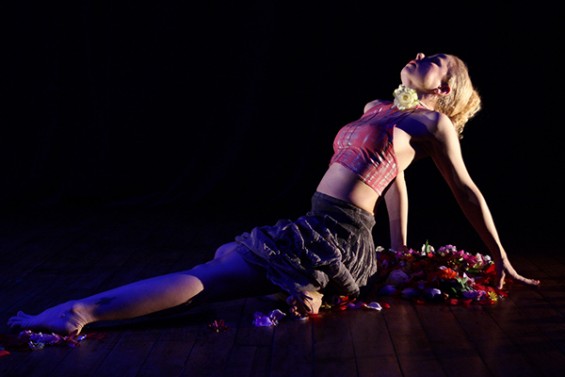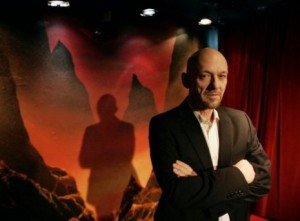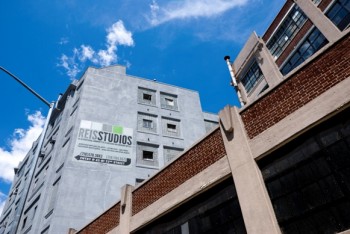
Valarie Green, Dance Entropy
Feb. 8, 2016 By Hannah Douglas
In Long Island City’s transformation from a manufacturing mecca to an arts and culture hub, the artists who chiseled and molded the region now appear anxious about what comes next.
Creative organizations and individuals in the area are clinging to the hopes of preserving their work places, though some have already fled due to staggering rent hikes in a rapidly developing area.
Renaissance sculptor Glenn Marlowe said he had to make a “costly” and “inconvenient” move eight months ago, instead of staying at his former space in the Wills Building at 43-01 21 St. Marlowe said his rent was going to go up 40 percent for a two-year lease.
Marlowe said he managed to get a longer, five-year lease at his new space – 44-02 11th St. – with the option to renew for five years. However, his rent is higher than he was paying before.

Falling Man, Glenn Marlowe
“Art survival in New York is difficult,” Marlowe said. “It’s a chaotic way to live.”
Messages left for the 21st Street property owner were not returned as of press time.
Valerie Green, who runs the dance company Dance Entropy, recently faced a 70 percent rent hike, which she said she negotiated to a 44 percent increase. Dance Entropy is located in the Silks Building at 37-24 24th St.
“I will need to close unless there are some heavy hitting donors,” Green said, adding that if her organization doesn’t see a big increase in revenue, it will be tough next year.
The rehearsal space, which has been in Long Island City since 2005, serves about 4,000 dancers and audience members each year.
“We’re a very small organization doing a lot of programming,” Green said.
Green’s building owner, Time Equities, Inc., declined to comment for this story.
In addition to the high costs of rent, production prices have gone up whereas the revenue has not, and for Richard Mazda, owner of the Secret Theatre (44-02 23rd St.) the math just doesn’t add up.
According to Mazda, the theater has $8,000 in monthly operational costs — about $6,000 for rent and $2,000 for wages and electricity — and that’s just to keep the place open. Then there’s an added minimum of about $4,000 to run a show.

Richard Mazda
At $18 a ticket, which is the highest price he can charge due to member guidelines set by the Actors’ Equity Association for Off Off Broadway, he said he has to sell 666 tickets per run of a show.
“That’s a lot of tickets,” Mazda said. “We hardly ever sell that many tickets for any show … Whichever way I do the figures, it’s just above what’s achievable at Off Off Broadway.”
Furthermore, the theater doesn’t host shows every day.
“You’re obviously not open Monday night, not open Tuesday night … so those are dead nights, but we still have costs,” he said. “The rent still has to be paid for Monday, it still has to be paid for Tuesday.”
Mazda recently launched a fundraiser on Indiegogo – not his first – and is looking at restructuring the organization to coordinate with nonprofits for finances.
Although he was very grateful for a $2,300 grant from the Queens Council on the Arts last year, he said it was only a small boost in a larger battle.
Funding opportunities are available through the Department of Cultural Affairs’ Cultural Development Fund (Feb. 8 deadline), but there are limitations.
For example, individual artists cannot apply. Funding assistance also cannot exceed 50 percent of each project’s budget.
Following the 2001 rezoning of Long Island City, the resulting development has led to approximately 35,000 new residents in the area, according to the New York Economic Development Corporation’s website.
Yet the shift toward residential product has pushed independent companies such as the Chain Theatre at 21-28 45th Road to relocate. Three years into a five-year lease, the Chain’s property owner decided to sell the building to make way for luxury condominiums.
Director Kirk Gostkowski said the company moved into the area because they saw its “potential,” especially with renovations taking place.
“We certainly didn’t think this was going to happen quite as quickly as it did … that we would be kicked out of this building.”
Going forward, Christina Perry, the group’s director of outreach, said the Chain has been able to keep its core programming, but they’ve seen a reduction of about 60 to 70 percent of their offerings.
Reis Studios, an artists’ workspace and gallery space at 43-01 22nd St., faces similar circumstances as the owner is looking to sell the building, and negotiations are ongoing in a court case.
Juvenal Reis said his company expanded in the building in 2012, and had a lease extension to 2030.
“We have a very positive relationship with the owner and we are trying to work out a situation that is good for both [of us],” he said. They hope to stay until 2030.
Roger Kaufman, the property owner, said he could not comment on Reis’ situation due to the ongoing court case, other than agreeing that they have an “excellent relationship.”
However, he noted, “the bottom line is the bottom line. If they can afford to stay, then I’d be glad to keep them.”
“I am not adverse to keeping any cultural entity here, I’ve always shown that,” Kaufman said. “But at the end of the day when market rates change, that’s how it has to be adjusted, and anybody who wants to is welcome to stay. We don’t differentiate between one and another – there’s other tenants who have trouble picking up market rates, too, it has nothing to do with being an artist.”
A lease extension was also available for groups like the Flux Factory, which offers low-cost sub-rental spaces to artists. Flux Factory received a good chunk of change from the City as well as New York State Council on the Arts and many other private organizations, and they signed on through 2021.
Executive Director Nat Roe said he would be “shocked” if they weren’t “priced out” at the end of their lease extension.
Looking ahead, legislation like the Comprehensive Cultural Plan signed into law last May analyzes the “availability and distribution of cultural activities throughout the city,” as well as factors like artists’ needs for affordable housing, which will be compiled in a report sent to the Mayor in 2017.
Additionally, the proposal known as the Small Business Jobs Survival Act, incorporates further protections for commercial renters like artists, and requires landlords to submit further notification if they aren’t renewing a lease. That proposal has the support of many legislators in the council but has yet to become law.
Yet, artists like Zoe Morsette, who has created costumes for shows such as “30 Rock” and “Saturday Night Live,” thinks history is just repeating itself.
Morsette has worked in many areas — from SoHo to Dumbo — and now Long Island City.
“I’ve been pushed out of every neighborhood I’ve ever worked in,” Morsette said.
“What I hate is that the developers use the art as a lure for a neighborhood like this, saying ‘Oh we’re so cultural. There’s dance classes and music school and theater…’”, she added. “And then those are the very people they force out.”
Additional reporting by Jackie Strawbridge
4 Comments







What we have is a sea change in values, of aggression in the face of the arts, as a “rightwing” point of view, all storm trooper conceit including the right of might to push aside any perceived weaker element or person, takes over.
Culture is everything. The arts enable empathy, so we need the arts to humanize. For, if the sole and chief value is power, pity us all.
By 2017, Long Island City will be ready for City protection of small jobs, as artists are getting beaten up by the hubris of greed, and the pitilessness of self-conceit. Storm troopers are a form of art, of theater, also.
Additionally, the City support, unfortunately, will push more artists out for high-tech small business owners, another underlying pressure. (“Get ’em out while you can.”)
“What I hate is that the developers use the art as a lure for a neighborhood like this, saying ‘Oh we’re so cultural. There’s dance classes and music school and theater…’”, she added. “And then those are the very people they force out.”
100% true. It’s a systemic problem that HAS to be fixed.
Somehow I think proximity to the City, Gantry State Park, and a lower cost than Manhattan have more to do with people coming to LIC than an “art community”. I see no reason to be worried about artists who can’t pay the rent being forced out. They really are not relevant to the future of the neighborhood.
Art people better watch out because BIG BUSINESS & DEVELOPMENT comes first in NYC Government.